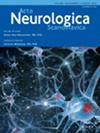To investigate whether glial fibrillary acidic protein (GFAP), neurofilament light chain (NFL), and 12 cytokines can serve as serum biomarkers of olfactory identification dysfunction in patients with Parkinson’s disease (PD). GFAP and NFL levels were measured in 75 patients with PD and 36 healthy controls (HCs). The levels of 12 cytokines were assayed in 41 patients with PD. The 16-item Sniffin’ Sticks test and the Mini-Mental State Examination (MMSE) were used to assess olfactory identification ability and cognitive function, respectively. Linear regression models were applied to control for confounding effects. Receiver operating characteristic curves were used to examine the diagnostic accuracy of serum NFL, GFAP, and interleukin-6 (IL-6) levels. The cut-off value for the SS-16 test in diagnosing dysosmia was equal to 9.5 points. Serum GFAP levels were higher in patients with PD with olfactory identification dysfunction than in those without. GFAP, NFL, and IL-6 levels were correlated with SS-16 scores. Moreover, combining these three biomarkers yielded the best-fitting model for distinguishing patients with PD with or without dysosmia. We found a prominent indirect effect of GFAP on MMSE scores through its contribution to SS-16 scores. GFAP, NFL, and IL-6 can serve as serum biomarkers for olfactory identification dysfunctions in PD. We inferred that astrogliosis might promote the occurrence of dysosmia by releasing proinflammatory factors and causing neuronal damage and may indirectly impair cognition through its effect on olfactory function.



